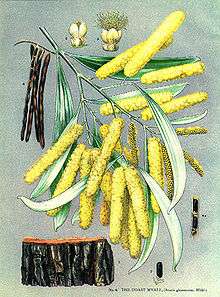Acacia binervia
| Coast myall | |
|---|---|
 | |
| Scientific classification | |
| Kingdom: | Plantae |
| (unranked): | Angiosperms |
| (unranked): | Eudicots |
| (unranked): | Rosids |
| Order: | Fabales |
| Family: | Fabaceae |
| Genus: | Acacia |
| Species: | A. binervia |
| Binomial name | |
| Acacia binervia (J.C.Wendl.) J.F.Macbr. | |
Acacia binervia, commonly known as the coast myall, is a wattle native to New South Wales and Victoria. It can grow as a shrub or as a tree reaching 16 m in height.[1] This plant is reportedly toxic to livestock as the foliage (phyllodes) contain a glucoside which can produce hydrogen cyanide if cut.[1]
Taxonomy
German botanist Johann Christoph Wendland first described this species as Mimosa binervia in 1798,[2] before American botanist James Francis Macbride reclassified it in the genus Acacia in 1919.[3] Common names include coast myall and rosewood.[3] Acacia glaucescens is an illegitimate name.[4]
Description
Acacia binervia grows as a shrub to small tree anywhere from 2 to 16 m (6.6 to 52.5 ft) high. The bark is dark brown to grey in colour, and the elliptic to sickle-shaped (falcate) phyllodes are 6–15 cm (2.4–5.9 in) in length and 0.5–2.3 cm (0.20–0.91 in) wide. The cylindrical yellow flowers appear in spring (August to October).[1] Flowering is followed by the development of 6–8 cm long seed pods, which are ripe by December.[5]
Distribution and habitat
Acacia binervia is found in central New South Wales from the Hunter Region south, and to Bungonia in the southwest, and continuing south into Victoria.[1] In the Sydney basin, it grows on a variety of soils and associated plant communities—alluvial soils, sandstone-, shale- or trachyte-based soils, generally with good drainage. It grows in dry sclerophyll forest, associated with such species as yellow bloodwood (Corymbia eximia), grey gum (Eucalyptus punctata), narrow-leaved ironbark (E. crebra), mugga ironbark (E. sideroxylon), or more open woodland with narrow-leaved ironbark and black cypress pine (Callitris endlicheri), and riparian (riverbank) forest with river peppermint (E. elata) and gossamer wattle (Acacia floribunda).[5]
Ecology
Acacia binervia regenerates from bushfire by a soil-borne seedbank, the seeds germinate and grow after fire while adult plants are killed. The frequency of fire for the cycle to persist is anywhere from 10 to 50 years.[5] It is useful to bees in the honey industry.[5]
References
- 1 2 3 4 P.G. Kodela. "New South Wales Flora Online: Acacia binervia". Royal Botanic Gardens & Domain Trust, Sydney, Australia.
- ↑ "Mimosa binervia J.C.Wendl.". Australian Plant Name Index (APNI), IBIS database. Centre for Plant Biodiversity Research, Australian Government.
- 1 2 "Acacia binervia (J.C.Wendl.) J.F.Macbr.". Australian Plant Name Index (APNI), IBIS database. Centre for Plant Biodiversity Research, Australian Government.
- ↑ "Acacia glaucescens Willd. [nom. illeg. ]". Australian Plant Name Index (APNI), IBIS database. Centre for Plant Biodiversity Research, Australian Government.
- 1 2 3 4 Benson, Doug; McDougall, Lyn (1996). "Ecology of Sydney Plant Species Part 4: Dicotyledon family Fabaceae" (PDF). Cunninghamia. 4 (4): 552–752. ISSN 0727-9620.
| Wikispecies has information related to: Acacia binervia |